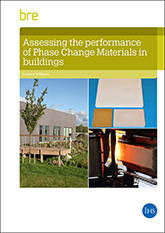Assessing the performance of Phase Change Materials in buildings
In December 2016, BRE published Assessing the performance of Phase Change Materials in buildings (FB 84), written by Corinne Williams.
Phase Change Materials (PCMs), or latent heat storage materials are an emerging technology in the UK construction industry. They have a large specific latent heat capacity, and can help improve the thermal performance of, and thermal comfort in low thermal mass buildings by lowering the peak temperatures resulting from extreme external temperature changes and preventing overheating.
This publication provides an overview of PCM building products and available methodologies for assessing them. It focusses on PCMs as part of a passive / fabric / thermal mass approach and will be of interest to specifiers, designers, installers, approving authorities, manufacturers, fire safety risk assessors and other interested parties.
The first part provides an introduction to PCM building products, covering; what they are and how they work, their benefits, current technical developments and available products. The second part covers testing and evaluation methodologies for long-term thermal performance, environmental impact, structural performance, health and safety considerations, and performance in fire and quality standards.
Its contents include:
- Acknowledgements
- Executive summary
- Glossary
- Introduction
- Assessment of PCMs and methodologies
- Quality schemes for PCM-specific attributes
- Conclusions and recommendations
- References
- Endnotes
The author Corinne Williams answered some questions about the publication:
| Did you have to test several cocktails during the writing of this publication? |
No! The ice cube example is a simple way to explain how PCMs work. Ice is a commonly used and well-known PCM.
An ice cube absorbs heat from a drink. When the ice cube reaches its melting temperature, it changes phase – from a solid to a liquid – and it absorbs large amounts of energy (at constant temperature) and cools the drink in the process.
| What are PCMs? |
A PCM is a material or substance which when changing its state – for example, from solid to liquid or liquid to solid – is capable of storing or releasing large amounts of energy at a constant temperature (the transition temperature). PCMs are referred to as latent heat storage materials.
| How are PCMs used in construction? |
PCM construction products need to be considered as part of the overall package of temperature control measures in a building and early specialist advice is desirable to ensure they are applied correctly and appropriately.
They can be used to provide thermal mass to buildings with low thermal mass to improve the thermal performance and indoor comfort.
PCMs incorporated into different construction products are available. Most of their applications are for inside buildings, such as ceilings and walls. PCM construction products come in various physical forms such as panels, plaster, boards and tiles and are available for different operating (or transition) temperatures.
PCMs in construction products simply absorb latent heat energy from the indoor environment when they change from solid to liquid when the indoor air temperature reaches the transition temperature, during the day. This process needs to reverse when the temperature drops during the night so the cycle can restart the next day.
| Where are PCMs being used? |
There are a number of demonstration and exemplar buildings where PCMs have been installed, including:
- The east wing of Somerset House, London, using clay boards containing PCM.
- The visitor centre at the BRE Innovation Park, Ravenscraig, Lanarkshire, incorporating a PCM ceiling panel system.
- The BASF Research House at the University of Nottingham, using PCM wall boards.
You can purchase the title at BRE Bookshop.
This article was originally published here on 15 Dec 2016 by BRE Buzz. It was written by Sheila Swan.
--BRE Buzz
[edit] Related articles on Designing Buildings Wiki
Featured articles and news
Infrastructure that connect the physical and digital domains.
Harnessing robotics and AI in challenging environments
The key to nuclear decommissioning and fusion engineering.
BSRIA announces Lisa Ashworth as new CEO
Tasked with furthering BSRIA’s impressive growth ambitions.
Public buildings get half a million energy efficiency boost
£557 million to switch to cleaner heating and save on energy.
CIOB launches pre-election manifesto
Outlining potential future policies for the next government.
Grenfell Tower Inquiry announcement
Phase 2 hearings come to a close and the final report due in September.
Progress from Parts L, F and O: A whitepaper, one year on.
A replicated study to understand the opinion of practitioners.
ECA announces new president 2024
Electrical engineer and business leader Stuart Smith.
A distinct type of countryside that should be celebrated.
Should Part O be extended to existing buildings?
EAC brands heatwave adaptation a missed opportunity.
Definition of Statutory in workplace and facilities management
Established by IWFM, BESA, CIBSE and BSRIA.
Tackling the transition from traditional heating systems
59% lack the necessary information and confidence to switch.
The general election and the construction industry
As PM, Rishi Sunak announces July 4 date for an election.
Eco apprenticeships continue help grow green workforce
A year after being recognised at the King's coronation.
Permitted development rights for agricultural buildings
The changes coming into effect as of May 21, 2024.























